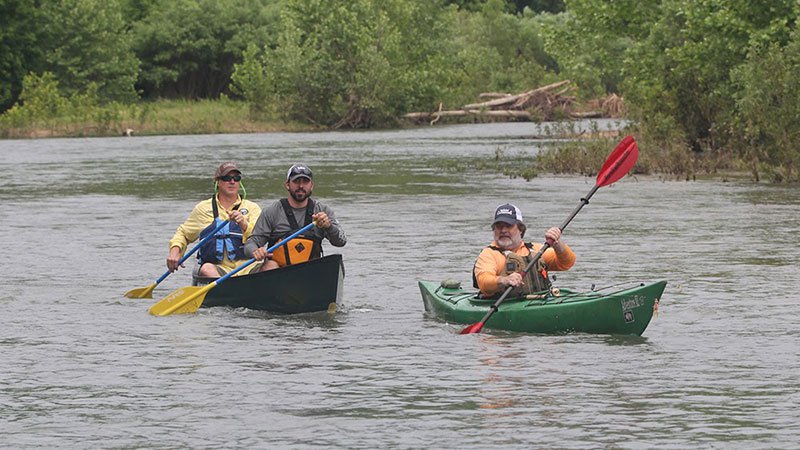By Jeff Williams Editor, Arkansas Wildlife Magazine
A friend of mine who grew up in Yell County was a regular visitor of the creeks that zig-zag through the Ozark and Ouachita mountains. One of his favorite fishing, swimming and paddling spots was Big Piney Creek in Pope County.
Big Piney’s Long Pool Recreation Area is popular among folks who canoe and kayak, and this young man knew well the 5-mile run down to Twin Bridges.
Big Piney can be a beast when its narrow watershed is raging after a downpour, although it wasn’t particularly rowdy that spring day. After my friend began his paddle at Long Pool, he dropped through a fast chute, was turned sideways and his canoe wrapped around a rock he had paddled by many times before. His boat – weighted down by the stream – trapped him underwater, within sight of people on the bank. By the time they were able to reach him, he had drowned in less than 4 feet of water before his 30th birthday.
Paddlers with wide ranges of skill levels drown for various reasons every year in Arkansas’s lakes, rivers and streams; a few have lost their lives this spring. The rapid rise in sales of recreational paddle boats, especially kayaks, means it’s likely more people with little experience are on the water. Experienced paddlers carry no guarantee of safety but their inexperienced colleagues certainly stand less chance of survival when trouble suddenly appears.
With a little forethought, preparation and practice, some of those disasters can be avoided.
- Above all, wear a well-fitting, U.S. Coast Guard-approved life jacket with the proper amount of buoyancy. It’s no guarantee, but no matter a paddler’s skill level, this is the best way to avoid drowning.
- Assume you will be immersed at some point during your adventure. Dress for the water temperature, not the air temperature, which leads to this advice: In cool weather, always pack dry clothes in a waterproof container to avoid hypothermia. Also pack an extra paddle with someone in your party.
- Research the water where you’ll be paddling. Many small streams can become raging torrents with only a slight bit of rain in the watershed. Rain miles upstream can cause sudden rises in water level and current. Be prepared to change locations or cancel if the forecast calls for rough conditions.
- Paddle water suited to your skill. This goes hand-in-hand with knowing the water you plan to paddle. Do not rely on someone else in your party to know all the details about the water level, where the put-in is and where the take-out is. Who will you call in a dangerous situation? Know this information before you go.
- If you’re a novice, paddle with someone who’s experienced and don’t paddle alone. Watch what they do and ask questions.
- File a float plan; let someone know where you’re going and when you expect to return.
- Don’t get a ticket – According to Arkansas law, children 12 and under must wear a U.S. Coast Guard-approved life jacket; everyone else must have one ready to use. Canoes and kayaks 16 feet and longer must have a throwable life preserver aboard. Glass containers are illegal in canoes and kayaks. Cooler lids must be securely fastened, each boat must have an attached, closeable trash container, and beverages must be in floating holders.
Are you thinking about buying your first new or used kayak? Here are some tips to consider.
- Buy a boat that fits what you intend to do. If you plan to learn to spend your time on whitewater, buy a whitewater boat. The same goes for recreational boats, made for slower streams and flat water, and longer kayaks built for speed. All these boats have characteristics that suit them to different types of water.
- Take your boat to a calm, shallow lake or pond and become familiar with it, preferably with an experienced paddler. Fill it with water to see how it changes (notice how heavy it is). Get in it and turn yourself over with someone nearby to help – it’s going to happen sooner or later and it’s best to learn how to deal with capsizing before you’re on moving water.
- Learn how to get back in, which is called self-rescue. This could save your life.
- After you’ve taken these steps on still water, do the same thing in a slow-moving creek. Work your way up to faster currents slowly; there’s plenty to enjoy along the way.
If paddling is for you and you’d like to learn various strokes and rescue techniques, take a class. Local groups such as the Arkansas Canoe Club welcome new members who are interested in learning. The American Canoe Association and the American Red Cross websites offer training videos, books and information about everything from paddling strokes to essentials for a float trip.







